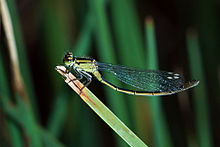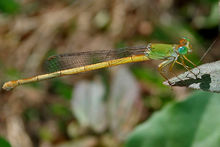Coenagrionidae
| Coenagrionidae | |
|---|---|

| |
| Male Ceriagrion glabrum | |
| Scientific classification | |
| Kingdom: | Animalia |
| Phylum: | Arthropoda |
| Class: | Insecta |
| Order: | Odonata |
| Suborder: | Zygoptera |
| Superfamily: | Coenagrionoidea |
| Family: | Coenagrionidae Kirby, 1890[1] |
| Diversity | |
| at least 110 genera | |
The insect family Coenagrionidae is placed in the order Odonata and the suborder Zygoptera.[2] The Zygoptera are the damselflies, which although less known than the dragonflies, are no less common. More than 1,300 species are in this family, making it the largest damselfly family. The family Coenagrionidae has six subfamilies: Agriocnemidinae, Argiinae, , , , and .[3]
This family is referred to as the narrow-winged damselflies or the pond damselflies.[4] The Coenagrionidae enjoy a worldwide distribution, and are among the most common of damselfly families. This family has the smallest of damselfly species. More than 110 genera of the family Coenagrionidae are currently accepted.[5][3]
Etymology[]
The name may be derived from Greek coen meaning shared or common and agrio meaning fields or wild.
Characteristics[]

- Usually have a black pattern
- Ground color may be green, blue, yellow, orange, or purple
- Narrow, stalked, usually colorless and clear wings
- Two antenodal cross veins
- Vein M3 arising nearer to nodus than arculus
Adults are seen around various habitats including ponds and wetlands. The females lay their eggs among living or dead submerged vegetation, and in some species, even crawl about underwater depositing their eggs. The nymphs are usually found in debris or among living or dead submerged plant material.[6]
Genera[]





These genera belong to the family Coenagrionidae:[7][8][3]
- Acanthagrion Selys, 1876
- Williamson & Williamson, 1924
- Kennedy, 1920
- Aciagrion Selys, 1891
- Williamson, 1917
- Africallagma Kennedy, 1920
- Agriocnemis Selys, 1877
- Machado, 2004
- Amphiagrion Selys, 1876 (red damsels)
- Kennedy, 1920
- Selys, 1863
- Bulla, 1973
- Lencioni, 2008
- Selys, 1876
- Anomisma McLachlan, 1877
- Ris, 1904
- Apanisagrion Kennedy, 1920
- Archibasis Kirby, 1890
- Fraser, 1948
- Argia Rambur, 1842 (dancers)
- Argiocnemis Selys, 1877
- Austroagrion Tillyard, 1913
- Lieftinck, 1953
- Austrocnemis Tillyard, 1913
- Kennedy, 1920
- Machado & Lencioni, 2011
- Azuragrion May, 2002
- De Marmels, 2005
- Caliagrion Tillyard, 1913
- St. Quentin, 1960
- Ceriagrion Selys, 1876
- Chromagrion Needham, 1903 (aurora damsels)
- Coenagriocnemis Fraser, 1949
- Coenagrion Kirby, 1890 (Eurasian bluets)
- Coryphagrion Morton, 1924
- Kennedy, 1920
- Machado, 2009
- Diceratobasis Kennedy, 1920
- Garrison & von Ellenrieder, 2008
- von Ellenrieder & Garrison, 2008
- Donnelly & Alayo, 1966
- Enallagma Charpentier, 1840 (American bluets)
- Epipleoneura Williamson, 1915
- Williamson, 1915
- Erythromma Charpentier, 1840
- Anjos-Santos, Lozano & Costa, 2013
- Lencioni, 1999
- Machado & Bedê, 2016
- Machado & Bedê, 2016
- Hesperagrion Calvert, 1902 (painted damsels)
- Hämäläinen & Marinov, 2014
- Kennedy, 1920
- Guan, Dumont, Yu, Han & Vierstraete, 2013
- Hylaeonympha Rácenis, 1968
- Idioneura Selys, 1860
- Santos, 1961
- Ischnura Charpentier, 1840 (forktails)
- Junix Rácenis, 1968
- De Marmels, 2003
- Selys, 1876
- Leptobasis Selys, 1877 (swamp damsels)
- Leptocnemis Selys, 1886
- Rácenis, 1959
- Villanueva, 2012
- Mecistogaster Rambur, 1842
- Megalagrion McLachlan, 1883
- Megaloprepus Rambur, 1842
- Donnelly, 1984
- Kennedy, 1920
- Sjöstedt, 1918
- Calvert, 1907
- Microstigma Rambur, 1842
- Fraser, 1953
- Santos, 1965
- Mortonagrion Fraser, 1920
- Nehalennia Selys, 1850 (sprites)
- Neoerythromma Kennedy, 1920 (yellowfaces)
- Neoneura Selys, 1860 (robust threadtails)
- Selys, 1891
- von Ellenrieder & Garrison, 2008
- Oreocnemis Pinhey, 1971
- Selys, 1876
- Kennedy, 1920
- Fraser, 1926
- Villanueva, 2012
- Ris, 1913
- Paracercion Weekers & Dumont, 2004
- Selys, 1863
- Hagen in Selys, 1860
- Williamson, 1916
- von Ellenrieder, 2008
- May, 2002
- Lieftinck, 1949
- Kennedy, 1920
- Proischnura Kennedy, 1920
- Selys, 1889
- Kennedy, 1920
- Protoneura Selys in Sagra, 1857
- Williamson, 1915
- Pseudagrion Selys, 1876
- Pseudostigma Selys, 1860
- Pyrrhosoma Charpentier, 1840
- Santos, 1966
- Villanueva, 2012
- von Ellenrieder & Garrison, 2008
- Laidlaw, 1915
- Teinobasis Kirby, 1890
- Selys, 1876
- Telebasis Selys, 1865 (firetails)
- De Marmels, 2007
- Thaumatagrion Lieftinck, 1932
- Calvert, 1909
- Machado, 2009
- Machado, 2009
- Ober & Staniczek, 2009
- Xanthagrion Selys, 1876
- Xanthocnemis Tillyard, 1913
- Xiphiagrion Selys, 1876
- Zoniagrion Kennedy, 1920
See also[]
References[]
- ^ Kirby, W.F. (1890). A Synonymic Catalogue of Neuroptera Odonata, or Dragonflies. With an Appendix of fossil species. London: Gurney & Jackson. pp. 202 [148]. doi:10.5962/bhl.title.5534.
- ^ Dijkstra, K.D.B.; et al. (2013). "The classification and diversity of dragonflies and damselflies (Odonata). In: Zhang, Z.-Q. (Ed.) Animal Biodiversity: An Outline of Higher-level Classification and Survey of Taxonomic Richness (Addenda 2013)". Zootaxa. 3703 (1): 36–45. doi:10.11646/zootaxa.3703.1.9. hdl:10072/61365. Archived from the original on 2018-08-14. Retrieved 2021-07-04.
- ^ a b c "World Odonata List". Slater Museum of Natural History, University of Puget Sound. 2018. Retrieved 2019-05-19.
- ^ Borror, D.J.; White, R.E. (1970). A Field Guide to Insects. Boston: Houghton Mifflin Company. ISBN 0-395-91171-0.
- ^ Integrated Taxonomic Information System (2007). Coenagrionidae, retrieved November 4, 2007.
- ^ John L. Capinera (2008). Encyclopedia of Entomology. Springer Science & Business Media. pp. 1244–1245. ISBN 978-1-4020-6242-1.
- ^ Dijkstra, Klaas‐Douwe B.; Kalkman, Vincent J.; Dow, Rory A.; Stokvis, Frank R.; et al. (2014). "Redefining the damselfly families: a comprehensive molecular phylogeny of Zygoptera (Odonata)". Systematic Entomology. 39: 68–96. doi:10.1111/syen.12035.
- ^ "Odonata Central". Retrieved 2019-05-19.
External links[]
- Info and Photos at BugGuide
- Images from Georgia, US
 Media related to Coenagrionidae at Wikimedia Commons
Media related to Coenagrionidae at Wikimedia Commons Data related to Coenagrionidae at Wikispecies
Data related to Coenagrionidae at Wikispecies
- Coenagrionidae
- Odonata families
- Odonata of Australia
- Odonata of Oceania
- Odonata of Asia
- Odonata of Africa
- Odonata of North America
- Taxa named by William Forsell Kirby
- Insects described in 1890
- Damselflies